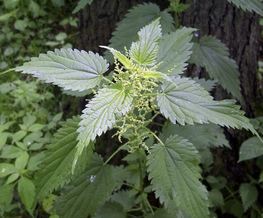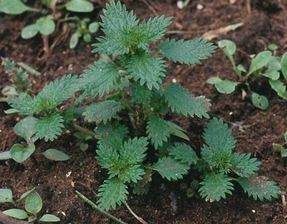I love nettle. I was introduced to this wild edible plant in my nutrition class by one of my favorite teachers, Brigitte Mars. She inspired me to use the wild plants that grow rebelliously around us, rather than curse them for popping up in the garden and across the yard. You may call them weeds, and call them what you wish, but many are edible, loaded with vitamins, minerals, and antioxidants and have healing powers beyond imagination.
Stinging nettle is a common perennial native to many countries including Europe, Asia, northern Africa, and North America. It is found in every state in the United States except Hawaii, growing abundantly in the Pacific Northwest and other areas which receive large amounts of annual rainfall. There are over 50 species, but the most common are Urtica dioica and Urtica urens. It’s often found around river banks and areas with rich soil. If you come across it, watch out! They call it stinging nettle for a reason…
The fine, hair-like thistles (or trichomes) on the leaves and stem will stick in your skin and leave a burning sensation. The trichomes inject several chemicals such as acetylcholie, histamine, and serotonin, which are in part responsible for the stinging sensation. However, using the plant to purposely sting an area of the body affected by pain and or inflammation can be therapeutic; it is a thousand year-old practice known urtication. The injected chemicals cause a rush of blood and antihistamines to the area. This reduces inflammation while energizing the nerves, muscles, capillaries, and local lymphatic system. It helps relieve the pain and inflammation of arthritis and MS, coldness in the limbs, gout, muscle weakness, and more (iPlant)
Nettle has been used for centuries to treat allergies, particularly hayfever. Allergy medicines, such Allegra and Claritin, can lose effectiveness over time and may leave a person with uncomfortable side effects such as drowsiness, dry sinuses, insomnia or even high blood pressure. But not nettle. Leave it to Mother Nature to provide us with “home-grown” remedies. Nettle has been studied thoroughly for its promising effectiveness at treating Alzhimers disease, arthritis, asthma, bladder infections, bronchitis, bursitis, gingivitis, hives, kidney stones, laryngitis, MS, PMS, prostate enlargement, sciatica, and tendinitis. Historically it has been used in the treatment of a long list of conditions such as acne, headaches, eczema, edema, food allergies, infertility, jaundice, hypoglycemia, night sweats, psoriasis, varicose veins and many more. This edible wild plant is rich in iron, making it a great supplement for those with anemia, and is a good source beta-carotene, vitamins B, C, E, K, and silica to name a few. David Hoffmann, author of the Holistic Herbal, once said, “When in doubt, use nettle.” Its healing power comes partly from its interaction with prostaglandins and other chemicals in the body responsible for inflammation; nettle is therefore considered anti-inflammatory and may also enhance the immune system. (Herbal Wisdom 2015).
Nettle can be eaten steamed like other leafy greens such as spinach or chard, and it has more nutritional value as far as vitamins and minerals go (iPlant). You can add the fresh leaves to pesto or to blender drinks. Steaming, blending, or drying and powdering will deactivate the trichomes. If you are a DIY-er, try making a powerful nettle tonic to take with you on the go. Nettle tea has a slightly sweet, grassy taste, similar to alfalfa. It has an aroma of green tea and is naturally caffeine free. I love Traditional Medicinals brand. It is a dieretic, so be sure to drink 2 glasses of purified water for every cup of nettle tea. Your kidneys will thank you.
Please note: If you are lucky enough to find nettle growing near you, be very cautious when harvesting. Always wear gloves and take care in the preparation process. Use only the above-ground portion of young plants; more mature plants can be upsetting to the kidneys and the digestive system. It is recommended to only use the urens and dioica species unless you have consulted with local herb authorities on the safety of other local verities.
References
- Herbal Wisdom. (2015). Nettle Benefits. January 7, 2015. Available at http://www.herbwisdom.com/herb-nettle.html
- Mars, Brigitte (n.d.). iPlant – Nettle.
Stinging nettle is a common perennial native to many countries including Europe, Asia, northern Africa, and North America. It is found in every state in the United States except Hawaii, growing abundantly in the Pacific Northwest and other areas which receive large amounts of annual rainfall. There are over 50 species, but the most common are Urtica dioica and Urtica urens. It’s often found around river banks and areas with rich soil. If you come across it, watch out! They call it stinging nettle for a reason…
The fine, hair-like thistles (or trichomes) on the leaves and stem will stick in your skin and leave a burning sensation. The trichomes inject several chemicals such as acetylcholie, histamine, and serotonin, which are in part responsible for the stinging sensation. However, using the plant to purposely sting an area of the body affected by pain and or inflammation can be therapeutic; it is a thousand year-old practice known urtication. The injected chemicals cause a rush of blood and antihistamines to the area. This reduces inflammation while energizing the nerves, muscles, capillaries, and local lymphatic system. It helps relieve the pain and inflammation of arthritis and MS, coldness in the limbs, gout, muscle weakness, and more (iPlant)
Nettle has been used for centuries to treat allergies, particularly hayfever. Allergy medicines, such Allegra and Claritin, can lose effectiveness over time and may leave a person with uncomfortable side effects such as drowsiness, dry sinuses, insomnia or even high blood pressure. But not nettle. Leave it to Mother Nature to provide us with “home-grown” remedies. Nettle has been studied thoroughly for its promising effectiveness at treating Alzhimers disease, arthritis, asthma, bladder infections, bronchitis, bursitis, gingivitis, hives, kidney stones, laryngitis, MS, PMS, prostate enlargement, sciatica, and tendinitis. Historically it has been used in the treatment of a long list of conditions such as acne, headaches, eczema, edema, food allergies, infertility, jaundice, hypoglycemia, night sweats, psoriasis, varicose veins and many more. This edible wild plant is rich in iron, making it a great supplement for those with anemia, and is a good source beta-carotene, vitamins B, C, E, K, and silica to name a few. David Hoffmann, author of the Holistic Herbal, once said, “When in doubt, use nettle.” Its healing power comes partly from its interaction with prostaglandins and other chemicals in the body responsible for inflammation; nettle is therefore considered anti-inflammatory and may also enhance the immune system. (Herbal Wisdom 2015).
Nettle can be eaten steamed like other leafy greens such as spinach or chard, and it has more nutritional value as far as vitamins and minerals go (iPlant). You can add the fresh leaves to pesto or to blender drinks. Steaming, blending, or drying and powdering will deactivate the trichomes. If you are a DIY-er, try making a powerful nettle tonic to take with you on the go. Nettle tea has a slightly sweet, grassy taste, similar to alfalfa. It has an aroma of green tea and is naturally caffeine free. I love Traditional Medicinals brand. It is a dieretic, so be sure to drink 2 glasses of purified water for every cup of nettle tea. Your kidneys will thank you.
Please note: If you are lucky enough to find nettle growing near you, be very cautious when harvesting. Always wear gloves and take care in the preparation process. Use only the above-ground portion of young plants; more mature plants can be upsetting to the kidneys and the digestive system. It is recommended to only use the urens and dioica species unless you have consulted with local herb authorities on the safety of other local verities.
References
- Herbal Wisdom. (2015). Nettle Benefits. January 7, 2015. Available at http://www.herbwisdom.com/herb-nettle.html
- Mars, Brigitte (n.d.). iPlant – Nettle.


 RSS Feed
RSS Feed